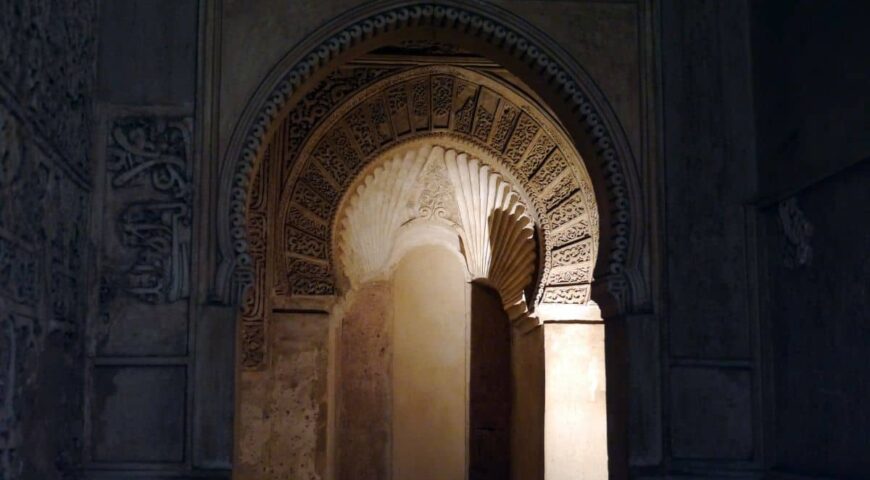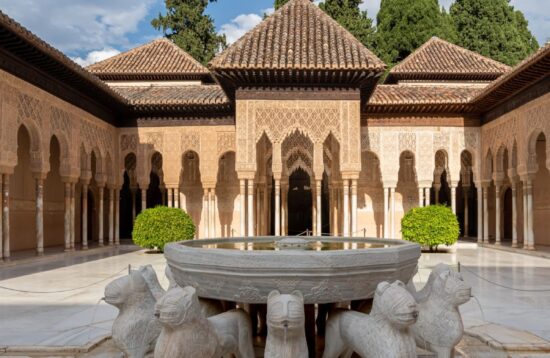
Hall of the Kings of the Alhambra, discover its inner beauty.
Nestled in the heart of Granada’s majestic Alhambra, the Hall of the Kings emerges as an architectural gem steeped in history and charm. This emblematic space, known for its rich ornamentation and its role in momentous historical events, captivates visitors with its beauty and unique atmosphere. To enter of this hall is to embark on a journey through time, where Islamic and Christian art, legends of lost loves and the grandeur of a glorious past intertwine. Discover the magic that surrounds this room and its significance in the context of the Alhambra.
Welcome to the Hall of the Kings, a place that transcends the barriers of time and envelops us in a universe of history, culture and fascination.
The Catholic Monarchs
During the capture of Granada by the Catholic Monarchs in 1492, the Hall of the Kings of the Alhambra played a historical role of great importance. This emblematic space became the setting for a momentous ceremony: the handing over of the keys to the city.
The conquest of Granada marked the end of Muslim domination in the region and the beginning of a new era under the rule of the Catholic Monarchs, Isabella and Ferdinand. The Hall of the Kings became the place chosen to carry out this significant ceremony. Here, the Christian monarchs received the keys of the city from the hands of the last Nasrid sultan, Boabdil, symbolizing the surrender and the end of the Muslim presence in Granada.
This act was the culminating point of a historical process that had begun years before with the Reconquest and that had its turning point in the conquest of Granada. The Hall of the Kings was erected as a symbol of this Christian victory and of the unification of the kingdoms of Castile and Aragon under a single crown.
The historical importance of this ceremony in the Hall of the Kings transcended the local sphere. It represented the end of centuries of confrontations and conflicts between the Christian kingdoms and the Muslim kingdom of Granada. The handing over of the keys was a milestone that marked the beginning of a new stage in the history of Spain and had significant repercussions both politically and culturally.
Today, when visiting the Hall of the Kings, one can feel the imprint of this historic moment. Visitors can imagine the solemnity and importance of this ceremony in this space. The hall becomes a tangible testimony of the convergence of different cultures and religions in the Iberian Peninsula, as well as the political and social changes that took place at that time.
The Hall of the Kings, with its history linked to the handing over of the keys of Granada, has become a landmark and an emblematic place in the Alhambra. It is a reminder of the past and a symbol of the historical transformation that occurred at that precise moment. By visiting this room, visitors have the opportunity to immerse themselves in history and understand the importance of that event in shaping modern Spain.

Architecture and design of the Hall of the Kings
The Hall of the Kings of the Alhambra stands out for its exceptional architecture and design. Its rectangular shape, typical of Islamic architecture, is complemented by a carved and painted wooden ceiling, which displays impressive craftsmanship and ornamental details. The walls are decorated with plasterwork, featuring geometric and vegetal motifs, highlighting the aesthetic refinement characteristic of the period. The room also has mullioned windows, which allow natural light to enter and create a fascinating play of shadows inside.
The Mudejar ceiling of the Hall of Kings
One of the highlights is its magnificent Mudejar ceiling. This carved and polychrome wood ceiling exhibits an exquisite combination of colors and intricate details. Decorative motifs include Arabic inscriptions, geometric patterns and stylized vegetal elements. The use of gold, red and blue colors creates an atmosphere of elegance and splendor. The Mudejar ceiling of the hall is a testimony to the technical and artistic skill of Muslim craftsmen, and reflects the influence of the Mudejar style in the Alhambra.
The frescoes in the Hall of the Kings
This Hall also houses frescoes that add a touch of beauty and narrative to its design. These murals depict historical and legendary scenes, such as the twelve kings of the Nasrid dynasty, representing the genealogy of Muslim rulers in the region. The frescoes also portray hunting scenes, paradisiacal gardens and other motifs that capture the daily life and culture of the time. These wall paintings, executed using natural pigments and fresco techniques, bring a sense of enchantment and evoke the hall’s past splendor.
The architecture and design of the Hall of the Kings, along with its impressive Mudejar ceiling and beautiful frescoes, are key elements that make this space an artistic and cultural treasure within the Alhambra. When visiting the hall, visitors can marvel at the architectural beauty, immerse themselves in the rich history and delight in the exquisite craftsmanship that distinguishes it.
The legend of the lovers
Within the walls of the Hall of the Kings, lies a love story that has endured over the centuries, enveloping the atmosphere with its charm and adding a touch of romance to the rich narrative of the Alhambra. This is the legendary story of the lovers Abu al-Hasan and Zoraida, whose destiny was cut short by the conquest of Granada.
Legend has it that Abu al-Hasan, a young Muslim prince, and Zoraida, a beautiful Christian maiden, met in the gardens of the Alhambra and fell madly in love. Their love blossomed amidst the lush landscapes and fascinating architecture of the Alhambra, and their secret meetings in this hall became the scene of their forbidden passion.
However, their love story was destined to face insurmountable obstacles. The conquest of Granada by the Catholic Monarchs threatened to separate them forever. Abu al-Hasan and Zoraida were caught in the whirlwind of war and historical transformation unfolding in the region.
As the Christian armies drew closer, Abu al-Hasan and Zoraida were forced to make difficult decisions. Loyalty to their own beliefs and to their respective communities led them their separate ways. Their love faded into distance and tragedy, leaving the Hall of Kings imbued with the melancholy of a lost romance.
The legend of the lovers has persisted through the centuries, adding a layer of mystery and romance to the ambiance of the Hall of Kings. Today’s visitors can immerse themselves in this fascinating story, letting their imaginations run wild as they wander the same corridors and walls that witnessed the secret meetings of Abu al-Hasan and Zoraida.
The Hall of Kings thus becomes a stage that evokes passion, tragedy and the enduring power of love. Its magical and captivating atmosphere fuels the legend of the lovers, turning the hall into a place where past and present intertwine in an eternal story of romance and loss.
Upon entering the Hall of Kings, visitors can feel the intensity of this story, which has been engraved on the walls and in the spirit of the place. The legend of the lovers is a testament to the power of the Alhambra to captivate hearts and awaken the imagination, creating a deep bond between visitors and the historical and romantic legacy of this magnificent palace.
If you are planning to visit the Alhambra, we recommend you to take the services of a tour guide so you don’t miss any detail of your wonderful visit!





